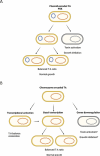Toxin-antitoxin genes are differentially expressed in Escherichia coli relA and spoT mutans cultured under nitrogen, fatty acid, or carbon starvation conditions
- PMID: 39895937
- PMCID: PMC11783221
- DOI: 10.3389/fmicb.2024.1528825
Toxin-antitoxin genes are differentially expressed in Escherichia coli relA and spoT mutans cultured under nitrogen, fatty acid, or carbon starvation conditions
Abstract
Introduction: The stringent response is one of the fundamental mechanisms that control and modulate bacterial adaptation to stress conditions, such as nutrient limitation. The accumulation of stringent response effectors, (p)ppGpp, causes differential expression of approximately 500 genes, including genes of bacterial endogenous toxin-antitoxin (TA) systems. However, the exact link between (p)ppGpp and toxin-antitoxin systems' activation, as well as toxin-antitoxin role in stress adaptation remains disputed.
Methods: In this study, we performed a complex analysis of changes (RNA-Seq) in the toxin-antitoxin operons' transcription in response to nitrogen, fatty acid, or carbon starvation, in bacteria with different abilities of (p)ppGpp accumulation.
Results and discussion: Although we observed that in some cases (p)ppGpp accumulation appears to be crucial for transcriptional activation of TA genes (e.g., ghoST, ryeA), our data indicates that the general pattern of chromosomally encoded TA gene expression in E. coli differs depending on the nutrient distribution in the environment, regardless of the alarmone accumulation.
Keywords: RNA-seq; ghoST; hokB; mqsRA; ppGpp; relA; spoT203; toxin-antitoxin.
Copyright © 2025 Maciąg-Dorszyńska, Olszewski, Karczewska and Boss.
Conflict of interest statement
The authors declare that the research was conducted in the absence of any commercial or financial relationships that could be construed as a potential conflict of interest.
Figures



Similar articles
-
Rapid Curtailing of the Stringent Response by Toxin-Antitoxin Module-Encoded mRNases.J Bacteriol. 2016 Jun 27;198(14):1918-1926. doi: 10.1128/JB.00062-16. Print 2016 Jul 15. J Bacteriol. 2016. PMID: 27137501 Free PMC article.
-
Hypothesis: type I toxin-antitoxin genes enter the persistence field-a feedback mechanism explaining membrane homoeostasis.Philos Trans R Soc Lond B Biol Sci. 2016 Nov 5;371(1707):20160189. doi: 10.1098/rstb.2016.0189. Philos Trans R Soc Lond B Biol Sci. 2016. PMID: 27672159 Free PMC article. Review.
-
A widespread toxin-antitoxin system exploiting growth control via alarmone signaling.Proc Natl Acad Sci U S A. 2020 May 12;117(19):10500-10510. doi: 10.1073/pnas.1916617117. Epub 2020 Apr 28. Proc Natl Acad Sci U S A. 2020. PMID: 32345719 Free PMC article.
-
Role of spoT-dependent ppGpp accumulation in the survival of light-exposed starved bacteria.Microbiology (Reading). 2002 Feb;148(Pt 2):559-570. doi: 10.1099/00221287-148-2-559. Microbiology (Reading). 2002. PMID: 11832519
-
(p)ppGpp and Its Role in Bacterial Persistence: New Challenges.Antimicrob Agents Chemother. 2020 Sep 21;64(10):e01283-20. doi: 10.1128/AAC.01283-20. Print 2020 Sep 21. Antimicrob Agents Chemother. 2020. PMID: 32718971 Free PMC article. Review.
References
LinkOut - more resources
Full Text Sources

